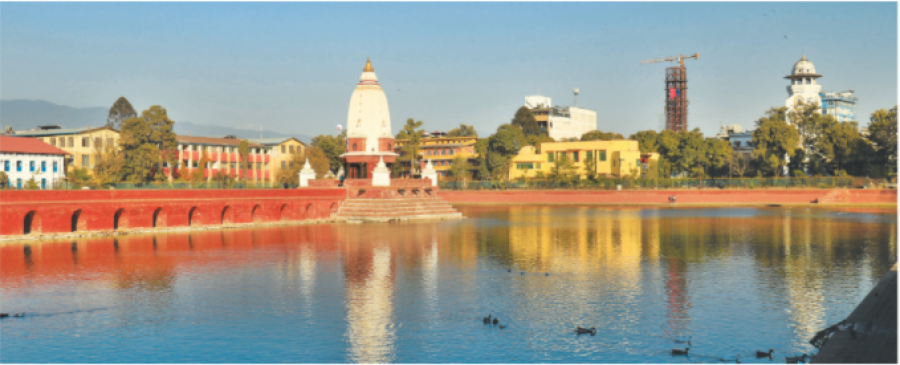Valley
National Reconstruction Authority hands over Rani Pokhari to Kathmandu Metropolitan City
But the City has yet to develop guidelines for the preservation of the 17th century pond. Heritage activists fear the City may develop the pond into a commercial project.
Anup Ojha
On Thursday, the National Reconstruction Authority’s Chief Executive Officer Sushil Gyewali handed over the historical Rani Pokhari pond to Kathmandu Metropolitan City’s mayor Bidya Sundar Shakya amid a function in the Capital.
The pond and the temple at its centre, which were damaged by the 2015 earthquakes, were restored by the reconstruction authority in two years. Work began in 2019 and completed last year.
Heritage activists and locals have expressed doubts whether the Kathmandu Metropolitan City will work sincerely to preserve the pond, which was built by King Pratap Malla in the 17th century.
“I am not optimistic about the Kathmandu mayor’s conservation efforts. The pond has been protected through the efforts and protests by heritage activists. But the mayor is still trying to claim credit for restoring the pond,” said Ganapati Lal Shrestha, one of the leading activists involved in the Rani Pokhari restoration campaign.
The reconstruction authority wanted to hand over the Rani Pokhari to the City last year itself but did not as the City could not develop clear guidelines for preserving the pond. But even a year later, the City has yet to develop the guidelines.
“This shows they are not serious. The mayor is not serious, and there’s something fishy about it,” said Shrestha. He fears the City may convert the historical pond into a commercial project.
It is learnt that the reconstruction authority had no option but to hand over the pond to the City even in the absence of guidelines because the authority’s term expired on December 24.
“The reconstruction authority’s term ended Thursday so we handed over the pond to the City and now the upkeep of the pond is their responsibility. We are hopeful that the City won’t repeat its past mistakes,” said Gyewali. By ‘past mistakes’, Gyewali was referring to the City’s plan in 2017 to restore the historical pond using modern construction materials including rebar and concrete and opening a coffee bar by the pondside.
“We wanted to make guidelines for preservation but City officials didn’t want it. But we have advised some natural ways to keep the pond clean and tips to maintain its natural environment,” said Gawali.
In 2017, when the Kathmandu Metropolitan City initiated the Rani Pokhari restoration project, it built a 10-feet high concrete retaining wall on the eastern side of the pond. Also Mayor Shakya announced to make it an artificial pond by flooring the pond bed with reinforced concrete. The move was roundely condemned from various quarters and the city was eventually forced to demolish the concrete wall and scrap its plan. Eventually, the parliament on January 28, 2019 entrusted the National Reconstruction Authority with the task of restoring the pond.
The authority completed the overall reconstruction work including the restoration of the Balgopaleshwar temple situated at the centre of the pond last year. The temple was rebuilt in its original Shikhara style as King Pratap Malla had constructed in 1670 AD.
President Bidya Devi Bhandari inaugurated the restored Ranipokhari in December last year.
According to Raju Man Manandhar of the reconstruction authority over Rs270 million was spent for the restoration of the temple and the pond, which spreads over 63 ropanis (3.2 hectares).
Meanwhile, heritage activist and lawyer Sanjay Adhikari who was also actively involved in the Rani Pokhari preservation campaign said the reconstruction authority should have involved the Department of Archeology while handing over the pond to the City.
“Involvement of the Department of Archeology along with the City would have ensured better upkeep of the historical pond. This would also prevent the City from acting arbitrarily,” said Adhikari.
According to the Ancient Monument Preservation Act 2013, structures over a hundred years old must be preserved in their original design by taking permission from the department.
The Director General at the Department of Archeology said he was not invited to the handover function.




 8.12°C Kathmandu
8.12°C Kathmandu.jpg)










